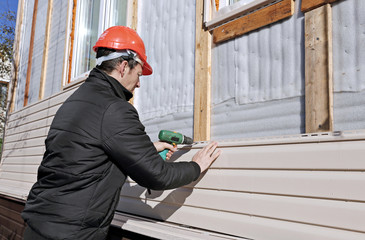Before installing your siding, Siding Contractors Seattle measures the wall area and considers the wall’s eaves and openings. They multiply the width and height to determine the square footage required for siding. Then divide the square footage by 100. They choose a water-resistant type of siding that does not require special installation tools. This type of siding is durable and will require fewer repairs over time.

Vinyl siding has become the most popular type of cladding in some countries. It is low-maintenance, durable, and comes in various colors and profiles. The material can be purchased in many different shapes and colors, and there are three main types of vinyl siding: premium grade, mid-grade, and low-grade vinyl. Depending on the type of wood used, it can vary significantly in its strength.
The colors of siding depending on the surrounding environment. Compared to the surroundings, colors appear more vibrant when exposed to sunlight. You can use unusual accents to give your home a modern edge by using an unexpected color scheme. On the other hand, cottage-style homes allow you more latitude when selecting siding colors. Keep in mind that color schemes can also be deceptive. Dark siding colors look rich when viewed alone, but they can create a gloomy feeling in a big house.
Siding installers must be well-versed in the materials that will be used. They must discuss the material’s composition and cost with you before starting the project. Sometimes they need to visit your house to get the measurements and visual inspection necessary for estimating the cost. Once the installation is complete, they will clean up the job site so that there’s no mess. In addition to siding materials, they will need scaffolding and other equipment to work correctly on the building.
A soffit is a structural element on the underside of the house. It covers the exposed surface beneath the roof overhang. Soffit panels are available in various colors, textures, venting options, and venting systems. If you’re a DIY-er, you can consider installing a soffit on your house. It is recommended that you blind-nail the panels. However, specific installations require face nailing.
A metal siding is an excellent choice if you’re looking for a durable, high-end option. It’s durable and resists various factors, but it isn’t the most economical option. In some states, aluminum siding is more popular than steel, which rusts easily. Steel, on the other hand, is the most durable option. However, the price of metal siding will depend on your budget and skills.
Fiber cement siding is another popular option. This type of siding is lightweight but durable, and it’s highly weather-resistant. It offers excellent protection against pests and the elements. And thanks to its many textures, it can look like wood or stone. These sidings are available in various colors and sizes, and you can easily complement the style of your home by choosing from these options. There are several benefits and disadvantages to each option, so make sure to select the right siding for your home.
Choosing siding is one of the most important aspects of improving the appearance of your home. Siding can add value to your house and lower your heating and cooling bills. But before you begin installing the siding on your home, make sure to get a quote from several contractors before you start. This will make the project much easier and faster. Once the installation process is finished, you can relax and enjoy your new siding! If done correctly, the process should take two to three weeks.
A lot of homeowners are concerned about the weight of vinyl and steel. However, these materials don’t require much maintenance and are generally lightweight. They can often be installed directly over existing materials, saving you labor costs. On the other hand, metal siding is more expensive and requires a highly skilled installation team. Metal siding is also a great option if you’re concerned about environmental issues. The latter is an excellent choice for many reasons.
Although stone and brick siding can last a long time, the materials used to build it are usually more expensive than those used for vinyl or fiber cement. Metal siding is prone to denting and is noisy. Fiber panels are often placed underneath the planks of metal siding to provide additional insulation to the walls. Aside from being affordable, steel and aluminum siding can be low-maintenance and require minimal maintenance. Installation and maintenance costs depend on the type of materials used, market conditions, and tariffs.